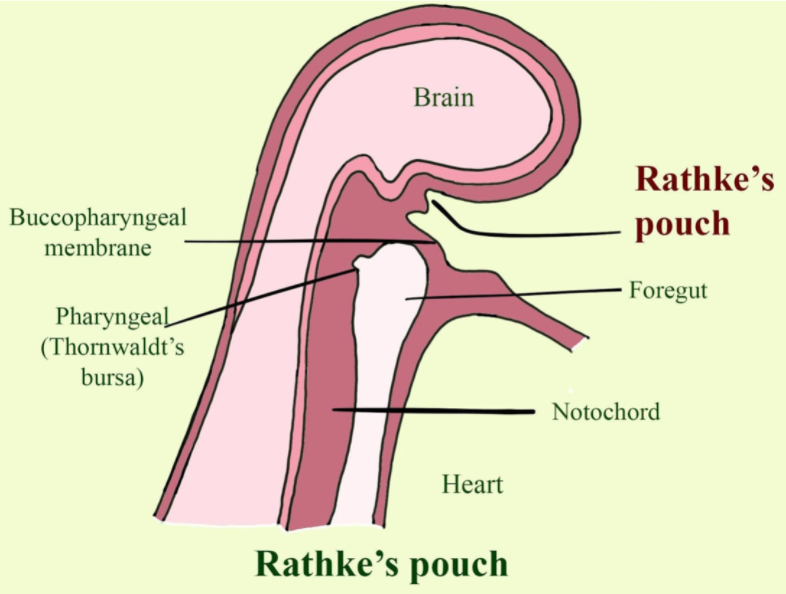
Rathke's pouch is
(a) Infundibulum
(b) Hypophysis
(c) Pituitary body
(d) None of the above.
Answer
462.3k+ views
Hint: When the embryonic development takes place, the diverticulum is made from the top of the buccal cavity which is in front of the buccopharyngeal membrane of the growing embryo. It is formed from the ectoderm. It is developed from the anterior pituitary.
Complete step by step answer:
During the formation of the embryo, Rathke's pouch is an outgrowth at the top of the growing mouth in front of the buccopharyngeal membrane. The anterior pituitary, a major part of the endocrine system develops from this.
Additional information:
- In time, the pouch will lose its link with the pharynx which in turn develops the anterior pituitary. The exterior wall of Rathke's pouch multiplies and completes the pouch to make pars distalis, pars tuberalis, and pars intermedia using the posterior wall.

- The multiplying anterior sometimes fails to fill the Rathke's pouch in some organisms, which in turn forms the Rathke's cleft among the pars distalis and pars intermedia.
- Benign tumours can grow in Rathke's pouch. Craniopharyngioma is an abnormal growth of a cell which develops from the epithelium of the cleft.
So, the correct answer is ‘Hypophysis’.
Note:
- Rathke's pouch is named after Martin Heinrich Rathke, who was a German embryologist and physician. He was born on August 25, 1793, and died on September 3, 1860.
- Martin Heinrich Rathke mastered medicine and natural history from the University of Göttingen, after which he gained his doctorate in medicine in Berlin. In the University of Dorpat, he became the professor of physiology and embryology in 1828.
- A benign growth on the pituitary gland inside the brain, precisely a mucin- filled tumour in the exterior part of the anterior pituitary gland in Rathke's cleft which takes place when the Rathke's pouch does not grow properly and limits its size in 2 to 40.
Complete step by step answer:
During the formation of the embryo, Rathke's pouch is an outgrowth at the top of the growing mouth in front of the buccopharyngeal membrane. The anterior pituitary, a major part of the endocrine system develops from this.
Additional information:
- In time, the pouch will lose its link with the pharynx which in turn develops the anterior pituitary. The exterior wall of Rathke's pouch multiplies and completes the pouch to make pars distalis, pars tuberalis, and pars intermedia using the posterior wall.

- The multiplying anterior sometimes fails to fill the Rathke's pouch in some organisms, which in turn forms the Rathke's cleft among the pars distalis and pars intermedia.
- Benign tumours can grow in Rathke's pouch. Craniopharyngioma is an abnormal growth of a cell which develops from the epithelium of the cleft.
So, the correct answer is ‘Hypophysis’.
Note:
- Rathke's pouch is named after Martin Heinrich Rathke, who was a German embryologist and physician. He was born on August 25, 1793, and died on September 3, 1860.
- Martin Heinrich Rathke mastered medicine and natural history from the University of Göttingen, after which he gained his doctorate in medicine in Berlin. In the University of Dorpat, he became the professor of physiology and embryology in 1828.
- A benign growth on the pituitary gland inside the brain, precisely a mucin- filled tumour in the exterior part of the anterior pituitary gland in Rathke's cleft which takes place when the Rathke's pouch does not grow properly and limits its size in 2 to 40.
Recently Updated Pages
Glucose when reduced with HI and red Phosphorus gives class 11 chemistry CBSE

The highest possible oxidation states of Uranium and class 11 chemistry CBSE

Find the value of x if the mode of the following data class 11 maths CBSE

Which of the following can be used in the Friedel Crafts class 11 chemistry CBSE

A sphere of mass 40 kg is attracted by a second sphere class 11 physics CBSE

Statement I Reactivity of aluminium decreases when class 11 chemistry CBSE

Trending doubts
The reservoir of dam is called Govind Sagar A Jayakwadi class 11 social science CBSE

10 examples of friction in our daily life

Difference Between Prokaryotic Cells and Eukaryotic Cells

State and prove Bernoullis theorem class 11 physics CBSE

Proton was discovered by A Thomson B Rutherford C Chadwick class 11 chemistry CBSE

State the laws of reflection of light




